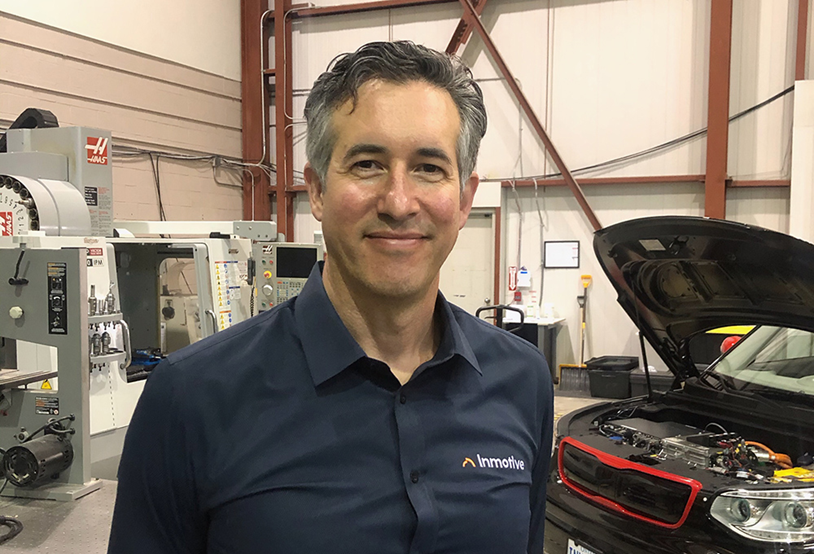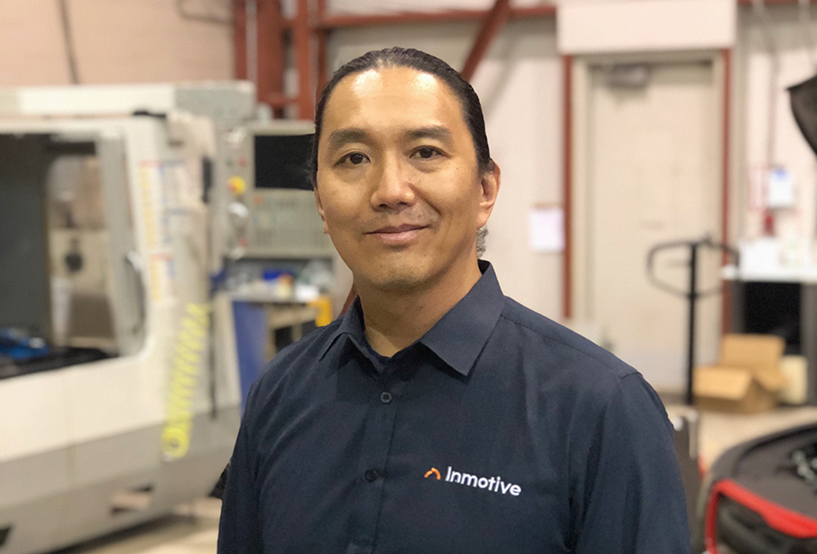 Ingear 变速器在从低速档向高速档换档的过程中,“关键扇区”从大链轮环、摩斯Hy-Vo静音链条和惰轮机构中滑出。(图片来源:Inmotive)
Ingear 变速器在从低速档向高速档换档的过程中,“关键扇区”从大链轮环、摩斯Hy-Vo静音链条和惰轮机构中滑出。(图片来源:Inmotive) Inmotive公司首席执行官 Paul Bottero (图片来源:Inmotive)
Inmotive公司首席执行官 Paul Bottero (图片来源:Inmotive) Ingear 双速变速器与基准单速电动汽车的Matlab WLTP能耗模拟比较汇总。(图片来源:Inmotive)
Ingear 双速变速器与基准单速电动汽车的Matlab WLTP能耗模拟比较汇总。(图片来源:Inmotive) Ingear的差速器处于嵌套状态位于齿轮链深处。(图片来源:Inmotive)
Ingear的差速器处于嵌套状态位于齿轮链深处。(图片来源:Inmotive) 另一个角度下的 Ingear 2 速变速器。(图片来源:Inmotive)
另一个角度下的 Ingear 2 速变速器。(图片来源:Inmotive) Inmotive 公司 CTO Tony Wong 开发的 Ingear 变速器概念来源于传统的自行车变速器。(图片来源:Inmotive)
Inmotive 公司 CTO Tony Wong 开发的 Ingear 变速器概念来源于传统的自行车变速器。(图片来源:Inmotive)
CAE 分析和原型测试表明,与单速变速箱相比,Ingear双速变速箱结合一些电机优化,系统效率可提高 7% 至 12%。据 Inmotive公司 CTO Tony Wong 介绍,Ingear 的加速、爬坡和牵引能力提高了 15%。Inmotive 公司已经为一辆起亚 Soul EV 安装了 Ingear 变速箱,用于技术演示。
Wong 将自己的发明呈现给科技界资深人士 Bottero 并开始一起搜索专利。Ingear 的“秘方”就是他们口中的“关键扇区”链轮组件(现已获得专利),用于控制链条与链轮之间的啮合。“很明显,自行车变速器肯定不能给汽车用,很快就会被碾碎的。”Wong 指出,“如链条行业所说的那样,就是这些关键扇区使我们能够始终保证链条与链轮齿之间的同步,即使是在换档过程中。”
2015 年,Inmotive 公司的新目标是让 Ingear 更加强劲耐用,适合于汽车应用。Wong 说,我们从早期迭代的齿带传动过渡到 Hy-Vo 链条(应用于雪佛兰 Volt 和大量四轮驱动分动箱),实现了更高的扭矩密度,“具有极高的耐用性和效率”。Bottero 补充道,“市场已经成熟,我们一直认为最适合我们的就是电动汽车市场。”
“货车制造商正在讨论使用我们的双速变速箱。”Bottero 说,“货车必须非常高效。首先,受到里程要求的限制,这种车型不可能配备一个超大的发动机;其次,它们的负载有很重,如果采用单速变速器又很难爬坡;另外,这些车辆对价格的控制也很严格,必须保证最终客户可以获得可观的投资回报。Ingear 可以提高车辆的爬坡能力。我们与卡车和客车制造商进行的分析表明,我们可以通过采用双速变速器并优化电机,提高车辆的提高爬坡能力。具体来说,我们可以让车辆以合理的速度和较低的传动比爬上 17% 的坡度。”
“我们正在洽谈中的厂商都很了解电机转速提高所带来的挑战。”Wong 指出,“转速到 16,000 转/分以上,向心力就会非常大。此时,空气隙将受到影响。你必须使用非常结实的轴承。即使是转子结构也会受到磁场的影响,因此它的机械强度必须足以承受巨大的向心力。涡流损耗会在电机高速运行时产生阻力和大量热量,减弱磁场也只能部分减少涡流损耗。
如果电动汽车适合使用双速变速器,那三速变速器是不是更好?Wong 说,Inmotive 公司的分析表明,三速变速器可以将轻型车辆的效率提高“一个百分点”,而四速变速器几乎不能提高投资回报率。因此,双速变速器真的非常实惠。”Bottero 声称,在量产条件下,汽车厂商需要为 Ingear 支付每车 150 美元的成本,但却可以通过调整电池、电机和逆变器的尺寸,为每辆乘用车节省超过 1,500 美元。Wong 对 Ingear在 2023 年底投产很有信心。
来源:SAE《汽车工程》杂志
A long-touted benefit of electric vehicles has been the utter simplicity of their drivetrains. With just a pair of reduction gears between the traction motor and final drive, single-speed gearing helps to minimize the bill of material (BoM) and driveline-system cost while delivering acceptable performance.
But the more demanding duty cycles of commercial EVs, off-road equipment and high-performance electric cars are prompting development of multi-speed solutions. Tesla got there first, albeit unsuccessfully, in 2007. While still a start-up staffed mainly by electronics engineers, Tesla developed its own 2-speed gearset for use in its Roadster sports car. Perhaps not surprisingly, catastrophic failures of early production units led Elon Musk to reluctantly commission a clean-sheet 1-speed unit engineered by BorgWarner with specifications from Tesla. Since then, 2-speed EVs have trickled into low-volume production at Porsche and exoticar maker Rimac. BMW used a 2-speed transmission on its hybrid I8, and ZF has prototyped a compact 2-speed unit. Enter Inmotive, a Toronto, Canada-based supplier founded in 2010, with a novel twist to the 2-speed (and potentially 3-speed) solution.
“We’ve been hearing from OEMs around the globe, with growing demand for a 2-speed EV solution that provides enhanced range, improved performance characteristics, and the opportunity to reduce cost by downsizing the batteries and motors,” said Paul Bottero, Inmotive’s CEO. His company’s product, known as Ingear, is currently under evaluation by passenger- and commercial vehicle makers.
Conceptually influenced by the classic derailleur-type bicycle drivetrain, Ingear uses off-the-shelf automotive technology and standard materials and processes to keep per-unit costs under $150. Features include a BorgWarner Morse inverted-tooth Hy-Vo silent chain, powder-metal components, and splash-lubrication rather than a pressurized pump
CAE analyses and prototype testing have shown the Ingear 2-speed gearbox, in combination with some electric-motor optimization, is capable of system-efficiency gains of 7% to 12%, compared to single-speed types. Acceleration, gradeability and towing are improved by up to 15%, according to Inmotive CTO Tony Wong. Inmotive has retrofitted a Kia Soul EV with Ingear for industry demonstrations.
Right-sizing the e-machine
The idea for Ingear came to Wong, an avid cyclist, during a commute ten years ago. “I was thinking about the torque-transfer inefficiencies of a bike transmission – the derailleur shoving the chain side to side, often with a slight misalignment of the chain,” he explained. “So, I thought, what if instead of moving the chain, we instead moved the sprocket underneath it? There is empty space between the sprockets; what if we cut the sprockets into ‘pie slices’ and devised a method of maintaining chain engagement with the sprocket teeth throughout the shift?”
Wong presented his invention to Bottero, a tech-industry veteran, and the two began a patent search. Among Ingear’s “special sauces” are what they call the “key segments” – the sprocket component (now patented) that controls chain-to-sprocket alignment. “Obviously a bike derailleur would never work in a car; it would grind itself to pieces very quickly,” Wong noted. “It’s the key segments that enable us to maintain, as the chain folks say, the ‘synchronicity’ of the chain with the sprocket teeth even during a gear shift.
These components are really what make the Ingear practical at automotive speeds, under automotive torque loads.” Also patented was a concept called the ‘sequencer’ which ensures that key segment always moves first during a gearchange.
To commercialize the Ingear technology, Bottero, Wong and another colleague founded Inmotive in 2010. “We spent the first five years working on industrial applications – equipment like crushers, conveyors, and HVAC fans for buildings,” Bottero noted. “These applications proved our core concepts and technology works. The 2-speed gearing comes into play under peak loads and allows you to right-size the electric motors.”
The next steps, in 2015, aimed at making Ingear more robust and durable for automotive. Transitioning from toothed-belt drive in early iterations to the Hy-Vo chain – used in the Chevrolet Volt and countless 4wd transfer cases – enabled much higher torque density “with supreme durability and efficiency,” Wong said. Added Bottero: “The market was ready for us; we always thought the best fit for us was EVs.”
Sprocket dynamics
On a typical EV with two helical-cut reduction gears, the electric machine’s output shaft turns about nine times for each revolution of the wheels. The Ingear replaces the second reduction gear with the Hy-Vo chain drive and a “morphing” sprocket, as shown in the animation. To execute a Low-High or High-Low shift, an actuator directs the five interlocking sprocket segments into place during one revolution of the wheels (about 30 milliseconds).
This changes the size of the sprocket, effectively increasing or decreasing the gear ratio. The segments slide on hardened steel pins, similar to those used in injection molding equipment, Wong said. When the segments are rigidly locked into a circle, they operate exactly like a conventional one-piece sprocket. The system’s patented geometry keeps motor and wheel speeds in sync.
A moving idler (similar in function to a derailleur idler) is used to take up chain slack as the high- and low-gear sprockets morph into each other. “We set the geometries so that the ‘wrap angles’ of the chain are appropriate in both low and high gear,” Wong said. “It took some time to work out the chain path, but we’ve got it down pat.” He said the Ingear can transmit continuous torque during the shift, from low gear to high gear.
“The motor speed comes down very quickly, resulting in a smooth shift that the passenger doesn’t feel,” Bottero explained. Wong’s team has developed torque-fill algorithms to further minimize any perception of gearchange to the vehicle occupants. In the process, less energy wasted equals more EV range per battery charge. Braking regeneration can be continuous even while downshifting, Inmotive claims. Enabling the electric motor to operate more efficiently allows more of the battery’s power to move the car rather than be wasted as heat.
“OEMs making delivery trucks are talking to us about 2-speed transmissions,” Bottero said. “Such vehicles have to be very efficient; they can’t have an oversized motor that will cost them range. With a 1-speed transmission, loaded, they’ll have difficulty getting up the largest hills. These vehicles also are built to a price point – the return on investment for the end customer is substantial. We can help make a vehicle that will handle a measurably higher grade; the analyses we’ve done with truck and bus manufacturers show that with 2-speeds and optimized motors, we can definitely improve gradeability. Get up that 17 percent grade, at a reasonable speed, by having that low-gear ratio.”
New transmissions prompt questions about ratio spread. Porsche’s planetary 2-speed in the Taycan EV uses a short 15.5:1 low gear to provide maximum acceleration, and a long-ratio 8.05:1 high gear for top speed and highway efficiency. Bottero and Wong said the Ingear architecture is scalable to cover broad applications.
“We’ve found that an approximately 2:1 ratio really opens up the capabilities of an electric motor,” Wong said. “For larger trucks and off-highway vehicles, really large spreads are going to be necessary – and probably more speeds overall. We can accommodate that. But for passenger cars and sports cars, a 2:1 ratio means that when you’re running on the highway, your motor can spin at half speed. That’s a huge improvement. We’re finding that OEMs are happy with that proposal.”
Three speeds the charm?
As SAE’s Automotive Engineering has reported, the trend in e-motors is to higher shaft speeds – beyond 20,000 rpm in some new designs. According to Wong, such high-speed machines will actually perform more efficiently at lower speeds, in conjunction with the Ingear 2-speed.
“All the OEMs we talk with seem quite aware of the challenges their motor designers face with the higher rpms,” he noted. “The centripetal forces at 16,000 rpm and above are significant. You start compromising air gaps. You need really good bearings. Even the rotor structure will have to be magnetically compromised, so it can be mechanically strong enough to withstand the huge centripetal forces. Field weakening only partly reduces the eddy current losses, which create drag and a lot of heat in motors at high speeds.
“We can get a lot more out of motors by not having to spin them to such high speeds,” he asserted. Using the 2-speed gearing helps keep the electric machine in or as close to its optimum-efficiency “island” at all times. That tends to be close to the base speed – around 4,000 rpm for a 10,000-rpm motor or a bit higher if the motor is optimized for the gearbox.
“The motor has to be sized to dissipate the heat created in its low-rpm, thermally dangerous operating range, and get it up into its high-efficiency ‘sweet spot’, where we can shift and keep it in that zone. The 2-speed gets the motor off the line and spinning faster, which prevents overheating,” Wong explained.
If two speeds are good for EVs, can three be better? Inmotive’s analyses show that three ratios in light vehicles may provide “another percent” efficiency, according to Wong. And with a fourth speed “the return on investment is negligible. That’s why two speeds really offer a lot of bang for the buck.” Regarding that “bang,” Bottero claims that for Ingear’s $150-per-vehicle cost, at high volume, OEMs can save more than $1,500 per passenger vehicle by right-sizing batteries, motors and inverters. He is optimistic for Ingear to enter production by late 2023.
等级
打分
- 2分
- 4分
- 6分
- 8分
- 10分
平均分
